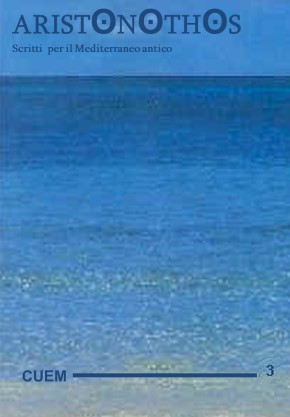La percezione antica dell'Orientalizzante
DOI:
https://doi.org/10.6092/2037-4488/368Abstract
This article analyzes the perceptions that the ancients had about two key objects of the Orientalizing period, the throne and the crater, considering literary traditions, both contemporary (Homer and the first lyric poets) and later (Atheneus of Naukratis, who quotes Dioscoris and Philochorus, Herodotus, Duris of Samos,…), as well as archaeological finds coming also from Etruscan and Latial areas (e.g. Nestor’s Cup). Both these objects characterized the royal, or at least princely, banquet (daís), until the middle VII century B.C., when the substitution of the usage of the throne (klismoi or thronoi, the latter already present in Mycenaean tablets) with that of the couch (kline) testifies to social evolution. The kline is just one of the ritual elements which differentiates daís (banquet) and symposion. If then, in the case of the throne and of related convivial habits it is possible to envisage an innovation from the Oriental world, datable with sufficient precision but diffused unevenly (e.g. Crete). In the case of the kratér or depas we can identify a continuity in usage as ritual gift (e.g. Sidonians’ bowl), votive offerings (e.g. Lydian kings’ craters) or reuse (sometimes with deceptive goals, as done by King Pausanias in Platea and Byzantium). Such an usage demonstrates how the awareness of the social preciousness of the apparatus described in these pages was crucial for its acceptance and utilization until the time of the Hellenistic courts.Downloads
Published
Issue
Section
License
The Authors retain the rights to their work and assign to the Journal the right of first publication of the work, simultaneously licensed under a Creative Commons License - Attribution 4.0 International which allows others to share the work indicating the intellectual authorship and the first publication on this Journal. The Authors also grant the perpetual right to distribute it free to the public in any medium and anywhere in the world, including communication to the public via the Journal's website.
The Authors may adhere to other non-exclusive license agreements for the distribution of the published version of the work (e.g. deposit it in an institutional archive or publish it in a monograph), provided they indicate that the first publication took place in this Journal.
The Authors retain the right to disseminate the work with open access, through their website or through an institutional or disciplinary archive, from the time of its publication.
The Authors retain the right to create derivative works and to reproduce, distribute, perform or publicly display their work during lectures, conferences or presentations, or other works of a scientific nature and professional activities by specifying the place of publication.
The Authors renounce, in agreement with the Publisher, any form of remuneration granted by the national legislation in force to authors and publishers for non-profit reprography and library loan rights.





